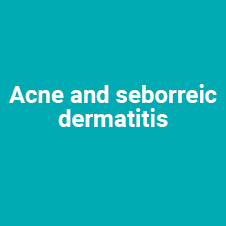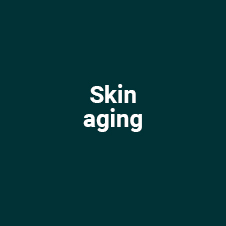THERAPEUTIC AREAS
All over the world dermatological pathologies have
a strong impact on the social, family and economic life of patients
THE DISEASES
Throughout its activity, Blufarma with its commitment has always worked on the formulation of products that help the medical specialist to improve the quality of life of their patients.

Immune responses can be classified into two categories: the innate (natural; non-specific) and the adaptive (acquired; specific) immune response.
The innate immune response involves neutrophil, eosinophil and basophil granulocytes, mast cells, dendritic cells, monocytes and macrophages, and natural killer (NK) cells. Their functions include phagocytosis, release of inflammatory mediators, cytokine production, and antigen presentation.
The adaptive immune response involves the immunoglobulin (Ig)/antibody-producing and secreting B cells as plasma cells, and T cells including CD4+ T helper cells and CD8+ cytotoxic T cells.
Innate immunity provides the first reaction of the immune response, while adaptive immune responses require more time for the activation of various lymphocyte subpopulations.

Tinea pedis is caused by an infection sustained by dermatophyte fungi, which attack the hairless skin, especially that of the feet; the disease mainly affects adult males, particularly when their immune systems are weakened or compromised.
The clinical and symptomatic picture of tinea pedis is characterized by: red skin, peeling of the skin, hyperkeratosis, thickening of the nails, smelly feet, itching, blisters filled with fluid on the sole of the foot, cracking of the skin.
Complications: bacterial superinfection

It is a chronic disease that cannot be cured. In any case, with appropriate treatment, you can enjoy long periods of remission. However, it is not to be considered a fatal disease.
It is a hereditary disease, but not all descendants are affected by the disease, in most cases the risk with an affected parent can be 50%; one speaks of hereditary genetic disease with incomplete penetrance.
The cause is due to mutations in the ATP2C1 gene, located on the short arm of chromosome 3, which codes for a calcium pump
Familial benign pemphigus usually arises late, after adolescence, towards the third-fourth decade of life and is characterized by the appearance of vesicles and erosions with crusty evolution located mainly at the level of the folds (axillary, inguinal, inframmary, antecubital and cavities popliteal), neck and chest (less frequently).

The human being is constantly exposed to fungi. Most people tolerate this exposure without consequences: immunocompetent subjects, that is, with a normally functioning immune system, have a high level of innate resistance to colonization by fungi.
Such fungi become pathogenic when the host is in a debilitated condition.
Candida normally lives as a commensal in many areas of the human body in the form of yeast. If it is not pathogenic, Candida is always in the form of yeast. When it becomes pathogenic, it protrudes from its membrane and becomes a hypha; in this state, he has the ability to "hang" on the underlying tissues and become an opportunist, that is, he takes advantage of a situation of immunosuppression to proliferate in an exaggerated way and cause candidiasis (or candidiasis).
When Candida causes candidiasis it is in effect also a parasite, that is an organism that lives on or inside a host and from which it benefits without giving any useful contribution in return, or even causing damage to the host.
Candidiasis is the most frequent human mycosis and is one of the most important problems of the immunocompromised person, that is, with an inefficient immune system.
If the human being is healthy, the Candida colonies present in the mucous membranes and on the skin are harmless, as the so-called good bacteria of the microflora and the immune system prevent their pathological proliferation.
However, when these two control systems fail, Candida begins to multiply intensively, triggering the condition known as candidiasis.

On the basis of the determining causes and the clinical features of presentation, two forms of contact dermatitis are distinguished:
1. Irritative Contact Dermatitis (DIC) is caused by repeated contact with solvents, cleaning agents or industrial materials capable of damaging the skin, without activating the immune response.
2. Allergic contact dermatitis (ACD), on the other hand, is caused by exposure to a substance (allergen) capable of triggering an immune reaction in previously sensitized subjects.

The purpose of the exudate is to limit the morbid process, preventing the spread of pathogens (thanks to the fibrin network), diluting any toxic substances, neutralizing the hyperacidity of the inflamed tissue and promoting the activity of leukocytes and the formation of fibrin. The exudate also facilitates the transport of antigens to local lymph nodes, via lymphatic drainage, for the specific immune response.
The exudate can be:
Serous: it is generally typical of milder inflammatory processes and poor in proteins; its consistency is similar to that of serum and may occasionally be found in certain diseases, such as tuberculosis.
Suppurative or purulent (pus): this yellowish exudate with a creamy consistency is typical of infected wounds and consists mainly of bacteria and decaying white blood cells.

Each hair has an attached gland that produces sebum, that is the fat that makes the skin elastic and protects it. If our skin produces excess sebum, it accumulates in the gland.
The sebum mixed with horny cells accumulates in the follicle, creating a sort of "plug", which prevents the secretion itself from flowing out. This is how the blackhead is formed, more commonly known as the black point, which constitutes the primary acne lesion. Inflammation of closed comedones is manifested by a slightly raised, reddened papule, on which a pustule (pimples) may overlap. The extension of the process in depth causes the formation of nodules and cysts. According to the presentation of the disorder, various types of acne are distinguished (vulgar comedonic, pustular, nodular and cystic).
Acne lesions usually appear on the face, shoulders and back. Often, these manifestations are associated with burning, itching and painful pressure. If the lesions are deep and chronic, the situation can become complicated and dark spots, nodules, cysts and permanent scars can appear on the skin.
Acne is the result of a complex mechanism, in which multiple factors contribute: hormonal variations, genetic predisposition, incorrect skin care, stress and some therapies.
Seborrheic dermatitis is a fairly common condition, which mainly affects the scalp; like all dermatitis it is characterized by inflammation of the affected area and redness, associated with an annoying itching sensation.
Seborrheic dermatitis consists of the loss of greasy scales, mainly caused by a fungus, known as Malassezia furfur (Pityrosporum ovale), which causes skin irritation: the cells, following the accelerated flaking to which they are subjected, produce scales, which occur in the form of crusts. In addition, often, greasy and yellow scales are associated with other skin manifestations such as folliculitis and erythema.
Seborrheic dermatitis is a chronic - relapsing disease: in addition to the scalp, it is found in the eyebrows, ears, groin and axillary areas, areas rich in sebaceous glands.
The scalp is the preferred soil for the fungus, because the altered sebum is suitable for its proliferation: the sebaceous glands present are hyperactive, consequently the composition of their secretion is altered (hence the adjective seborrheic).

Several factors favor the onset of mycosis in humans, including: the use of antibiotics, a reduced efficiency of the immune system and the presence of a state of diabetes.
According to the site of infection, mycoses are divided into: superficial mycoses and cutaneous mycoses.
Superficial mycoses affect the outermost layers of the skin and hair / hair. (Black Piedra, White Piedra, Pityriasis versicolor, Tinea nigra)
Cutaneous mycoses affect the keratinized layers of the epidermis and skin appendages, such as hair / hair and nails. Unlike superficial mycoses, cutaneous mycoses evoke an immune response and involve the degradation of the epidermal layers of keratin, inducing irritation, inflammation or, in some cases, even allergic reactions. Pathologists also call cutaneous mucous membranes with the generic term "ringworm". The fungi that cause cutaneous mycoses are better known as dermatophytes or dermatomycetes. Dermatophytes have the particularities of being filamentous fungi and reproducing by means of spores. In nature, there are three genera of dermatophytes: the genus Microsporum, the genus Trichophyton and the genus Epidermophyton.

Suppurative hidradenitis acts locally; to be precise, she has a preference for the armpits, the region just below the breasts, the groin, the genital area, the area in the middle of the buttocks and, finally, the perianal region.
It is not possible to heal from hidradenitis suppurativa; however, different treatments are available, both pharmacological and surgical, which allow to control the symptoms and improve, in an excellent way, the standard of living of patients.

Skin ulcers can arise as a result of physical trauma, with or without vascular damage, which triggers a loss of tissue. Other causes include infections, venous stasis, vasculitis, neoplasms, neurological problems, and autoimmune diseases with vascular involvement.
Pressure ulcers or pressure ulcers, common in patients who are bedridden for a long time, are caused by a lack of adequate blood supply. In addition, there are diabetic ulcers, which have a neuropathic origin. They usually affect the lower limbs and are caused by an alteration in the blood flow that leads to tissue damage.

It can be acute (ulcerative or non-ulcerative) or chronic.
Acute ulcerative blepharitis is usually caused by a bacterial (usually staphylococcal) or viral (e.g. herpes simplex or varicella zoster) infection. Acute non-ulcerative blepharitis is mainly due to seasonal or contact allergic reactions and is often associated with rosacea and seborrheic dermatitis.
Chronic blepharitis, on the other hand, can be caused by an altered secretion of the meibomian glands; these anatomical structures are located in the thickness of the eyelid and have the task of secreting a mixture of lipids that reduces the evaporation of the aqueous component of the tear film. Another chronic form is seborrheic blepharitis.

The underlying causes of dry eyes can be numerous. In some cases, this manifestation is due to poor production or excessive evaporation of the tear film that covers the eye and, as a rule, lubricates and protects it. The quantitative or qualitative alteration of the tears can occur in the case of blepharitis, conjunctivitis and other inflammatory diseases of the eye. However, dry eyes can also be caused by prolonged use of contact lenses, eye drops, or systemic medications, including antidepressants, beta-blockers, diuretics, and anticholinergics. Other times, dry eye is the manifestation of poorly treated vision problems or systemic diseases, such as systemic lupus erythematosus, rheumatoid arthritis, Sjögren's syndrome, insufficient vitamin A intake, etc.
Advanced age, menopause, prolonged visual strain and exposure to irritating agents for the conjunctiva of the eye, such as very bright sunlight, dry or windy environment, cigarette smoke, airborne dust, pollen and dust, can promote dryness eye.

This pathology is associated with the aging process and occurs mainly in people over the age of 50.
The macula rests on a layer of cells (pigment epithelium), lined externally by the vascular tunic (choroid). With advancing age, the pigment epithelium loses its ability to eliminate debris, which accumulate and settle under it, while the blood vessels of the choroid, necessary to carry oxygen and nourishment to the retina, undergo a gradual sclerosis.
Symptoms of dry macular degeneration include visual blurring and the perception of a dark or blank area in the center of the visual field. Over time, this blind spot becomes larger and further impairs vision, making reading, driving, and other daily activities more difficult. The most common symptoms include: gradual loss of night vision, decreased visual acuity, photophobia, difficulty in adapting from dark to light and in distinguishing colors. Straight lines may appear curved, contrast sensitivity decreases, and objects appear offset in shape and size from before.
The treatment uses food supplements based on antioxidants, intravitreal injection of vascular endothelial growth factor receptor antagonists (anti-angiogenic drugs), laser photocoagulation, photodynamic therapy and devices to correct low vision, such as glasses.

The pathogens responsible for this condition are the fungi of the genus Malassezia; these microorganisms are normally present on the skin, but only in some susceptible individuals can they cause disease.
Tinea versicolor is often associated with increased sebum and sweat production. This skin infection is favored by the combination of heat and humidity, by ineffective personal hygiene and by immunosuppression secondary to certain drug therapies, malnutrition, diabetes and other systemic diseases.
Tinea versicolor manifests itself with the appearance of small flat and discolored spots, often well demarcated. The lesions preferably appear on the upper body (neck and back) and can flow together into a larger patch.
The treatment of tinea versicolor involves the use of antifungal drugs to be applied locally on the skin (in the presence of a localized infection) or to be taken orally (in the case of extensive disease or frequent relapses). Pityriasis versicolor is generally chronic and persistent; therefore, the doctor can also prescribe an adequate therapeutic regimen to prevent relapses.
The therapeutic approach generally involves the use of antifungal drugs to be applied to the skin or to be taken orally. In most cases, topical treatment of tinea versicolor is sufficient.
Tinea versicolor is a mycosis characterized by frequent relapses after treatment, as the responsible microorganism is a normal host of the skin. The likelihood of relapses depends above all on the individual predisposition.
The prevention of tinea versicolor is possible by respecting simple hygiene rules. In particular, when you are predisposed to infection, it is important to avoid prolonged exposure to moisture and, if the fungal infection is already underway, to keep the affected area dry.

The timing and modalities of skin aging are influenced by the genetic heritage. However, genetic factors are not the only ones responsible for skin aging.
In any case, advancing age involves changes in all components of the integumentary system. Already at the end of growth, the skin begins to age, in relation to age and individual characteristics.
Intrinsic - or chronological - aging depends substantially on genetic (or intrinsic) factors; in principle, it begins after the age of 25 and involves a series of modifications that lead to the thinning and collapse of the skin structure
Extrinsic skin aging - or environmental factors - caused by external factors (extrinsic factors) and environmental factors including UV radiation (responsible for photoaging), cigarette smoking, alcohol abuse, pollution and continuous contact with irritants.
The appearance of imperfections of time such as wrinkles and hyperpigmented spots is not the only consequence of skin aging. In fact, there is a relationship between aging and carcinogenesis. First of all, because in the elderly the programmed death of "crazy" cells (apoptosis) is much less efficient than in young individuals. In addition, antioxidant defenses and DNA repair capacity also decrease in the elderly. At the same time, the ability of the skin itself to repair itself decreases and - as we have said so far - there is a greater susceptibility, not only to skin cancers, but also to the contraction of infections.

 © 2020 BluFarma.- Via Eupoli 132 - 00124 - Roma - Italia -
© 2020 BluFarma.- Via Eupoli 132 - 00124 - Roma - Italia - 
